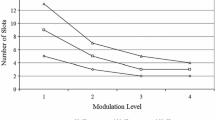Abstract
This article presents an algorithm for dynamic-routing and wavelength assignment (D-RWA) in an optical WDM network. The approach is based on a genetic algorithm (GA) and it includes a connection admission control (CAC), to provide a network with simultaneous fairness in distance and bandwidth capacity. The algorithm is evaluated by means of computer simulations using a mesh network with two types of node architectures capable of performing traffic grooming. Combining the two types of nodes, the performance of four network configurations is compared. Assuming that one of the two node types is more costly, two sparse node allocations are suggested to maintain the network cost-effective. The algorithm assigns wavelengths to the ligthpaths, routes the traffic streams, manages the grooming of sub-wavelength tributaries onto full wavelength channels, provides fairness, and minimizes the overall blocking probability of connection requests. Numerical results attest the usefulness of the proposed approach considering several scenarios of distance and bandwidth capacity classes of requests. Simultaneous and isolated simulations of the two fairness schemes are also compared, emphasizing the versatility of the algorithm.
Similar content being viewed by others
References
Bisbal D. et al. (2004). Dynamic routing and wavelength assignment in optical networks by means of genetic algorithms. Photonic Netw. Commun. 7(1): 43–58
Mohan G., Akash K. and Ashish M. (2005). Efficient techniques for improved QoS performance in WDM optical burst switched networks. Comput. Commun. 28(7): 754–764
Rao S.D., Saradhi C.V. and Murthy C.S.R. (2004). Preferred link based distributed adaptive routing in wavelength routed optical networks. Photonic Netw. Commun. 7(1): 17–35
Thiagarajan S. and Somani A.K. (2001). Capacity fairness of WDM networks with grooming capabilities. Opt. Netw. Mag. 2(3): 24–32
Choi J.S. (2003). Performance analysis of a bandwidth guaranteed medium access control protocol for WDM local networks. Photonic Netw. Commun. 6(1): 69–81
Wei W., Zenq Q.J., Liu J.M., Huang J. and Xiao P.C. (2004). Differentiated multi-layer integrated routing in IP over WDM networks. Compt. Commun. 27(16): 1594–1607
Wei W., Zenq Q.J., Ye T. and Lomone D. (2004). Adaptive differentiated integrated routing scheme for GMPLS-based optical Internet. J. Commun. Netw. 6(3): 269–279
Mosharaf K., Lambadaris I. and Talim J. (2005). A call Admission control for service differentiation and fairness management in WDM grooming networks. Opt. Switch. Network. 2(2): 113–126
Cerutti I. and Fumagalli A. (2005). Traffic grooming in static wavelength-division multiplexing network. IEEE Commun. Mag. 43(1): 101–107
Sabella R., Iovanna P., Oriolo G. and D’Aprile P. (2004). Strategy for dynamic routing and grooming of data flows into lightpaths in new generation network based on the GMPLS paradigm. Photonic Netw. Commun. 7(2): 131–144
Bosco A., Manconi E. and Sabella R. (2004). An innovative solution for dynamic bandwidth engineering in IP/MPLS networks with QoS support. Photonic Netw. Commun. 7(1): 37–42
Parthiban R., Tucker R.S. and Leckie C. (2003). Waveband grooming and IP aggregation in optical networks. IEEE/OSA J. Lightwave Technol. 21(11): 2476–2488
Dutta R. and Rouskas G.N. (2002). Traffic grooming in WDM networks: past and future. IEEE Netw. 16(6): 46–56
Ho P.-H., Mouftah H.T. and Wu J. (2003). A scalable design of multigranularity optical cross-connects for the next-generation optical internet. IEEE J. Sel. Area. Comm. 21(7): 1133–1142
Zhu K., Zang H. and Mukherjee B. (2003). A comprehensive study on next-generation optical grooming switches. IEEE J. Sel. Area. Comm. 21(7): 1173–1185
Sabella R. et al. (2003). A multilayer solution for path provisioning in new-generation optical/MPLS networks. IEEE/OSAJ J. Lightwave Technol. 21(5): 1141–1155
Lima M.A.C., César A.C., Araújo A.F.R.: Optical network optimization with transmission impairments based on genetic algorithm. Proceedings of the SBMO/IEEE IMOC, vol. 1, pp. 361–365. Foz do Iguaçu, Brazil, Sept. 2003
Ramakrishnan K.G. and Rodrigues M.A. (2001). Optimal routing in shortest-path data networks. Bell Labs Tech J. 6(1): 117–137
Chen B. and Wang J. (2002). Efficient routing and wavelength assignment for multicast in WDM networks. IEEE J. Sel. Area. Comm. 20(1): 97–109
Man K.F., Tang K.S. and Kwong S. (1996). Genetic algorithms: concepts and designs. IEEE Trans. Ind. Elec. 43(5): 519–534
Ali, M., Cosaque, D.E.D, Tancevski, L.: Network optimization with transmission impairments-based routing. Proceedings of 27th European Conference on Optical Communication-ECOC’01, vol. 1, pp. 42–43. Amsterdam, Nederland, Sept. 2001
Author information
Authors and Affiliations
Corresponding author
Rights and permissions
About this article
Cite this article
Lima, M.A.C., César, A.C. Simultaneous effect of connection admission control in distance and bandwidth capacity on WDM network performance. Photon Netw Commun 15, 251–261 (2008). https://doi.org/10.1007/s11107-007-0099-5
Received:
Accepted:
Published:
Issue Date:
DOI: https://doi.org/10.1007/s11107-007-0099-5




